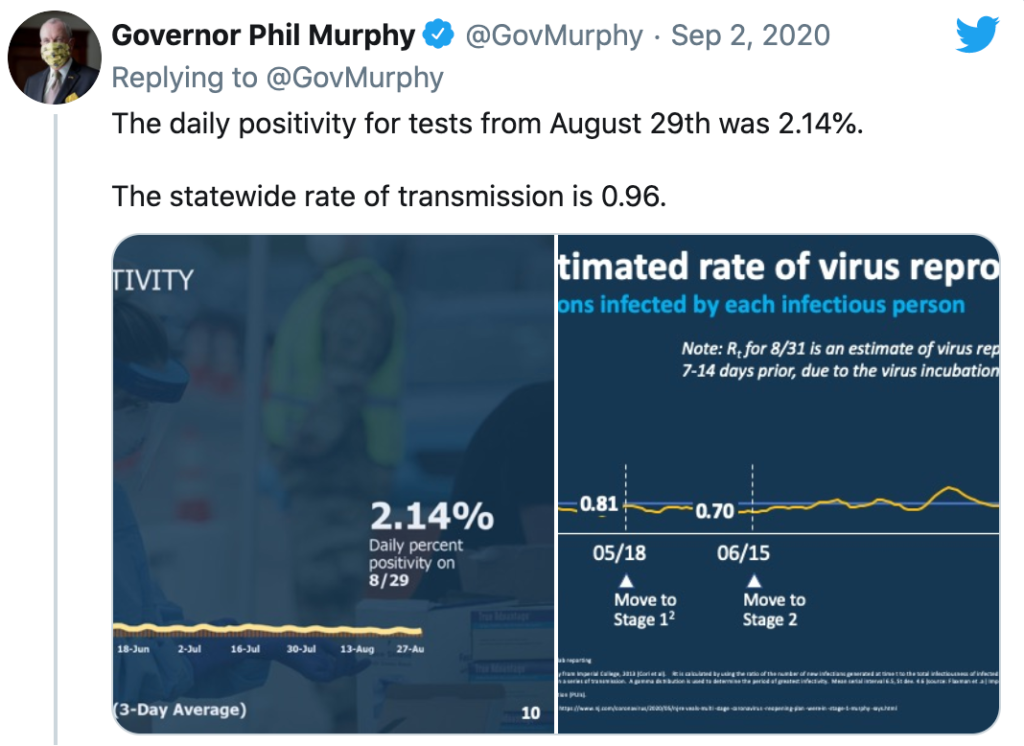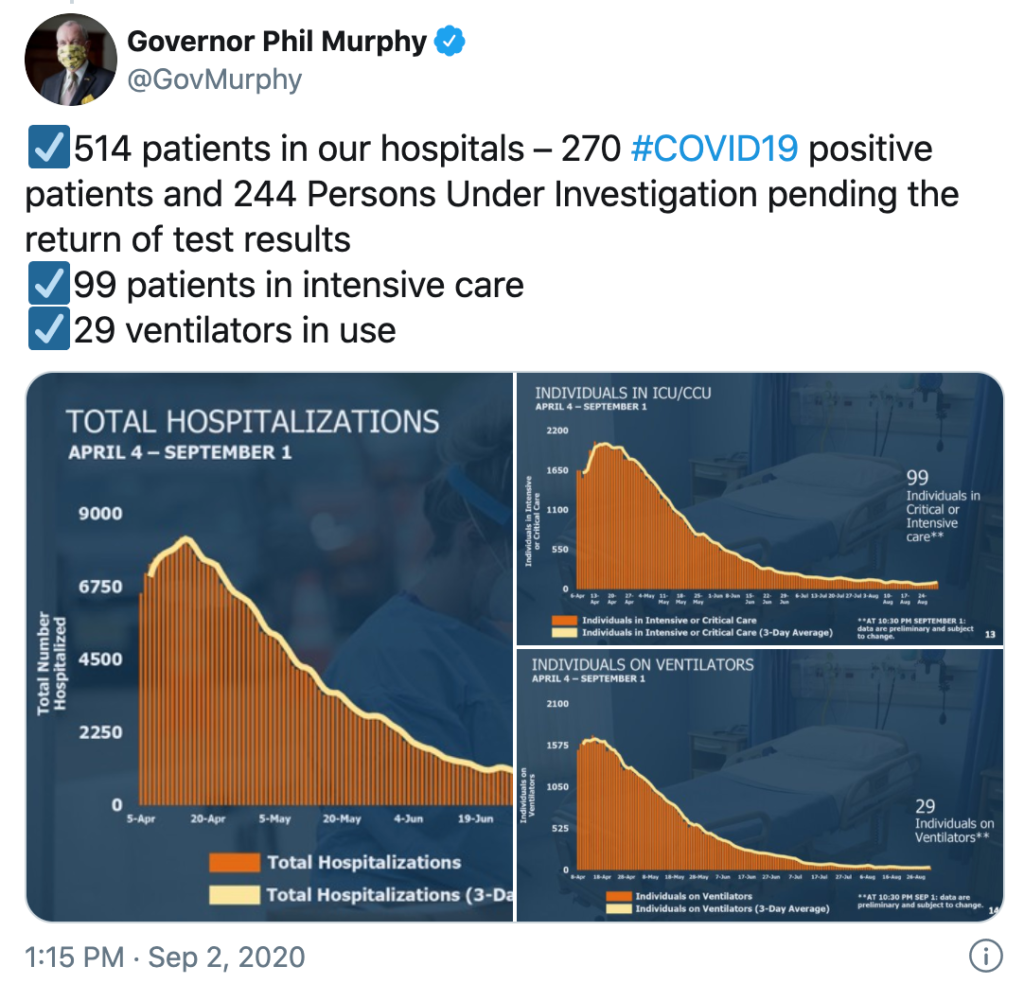Gov. Murphy says NJ has now moved "well into" stage three of the state's coronavirus reopenings. Here's what that means, and what's next.
By Tom Davis, Patch Staff
Sep 3, 2020 9:16 am ET|Updated Sep 3, 2020 7:21 pm ET
NEW JERSEY – New Jersey has achieved a significant milestone as the state's metrics in the coronavirus crisis continue to drop: The Garden State has moved into "stage three" of its reopening plan.
Stage three is not the last stage of the reopening process, and there are still components of New Jersey's economy that remain closed – or their reopening was strictly limited, and can still be expanded (see list of what's open, what's not, and the reopening chart below).
But Gov. Phil Murphy said the state "largely ticked through the box things in stage two and at this point, we're well into stage three, whether in substance form or otherwise."
The last stage in the state's reopening plan is called "New Normal," and New Jersey would enter it if there was widespread distribution of a vaccine or treatment.
Murphy did warn that he could easily revert back to stage two – or reverse some reopening decisions – if New Jersey's numbers tick back up, or if there is a second wave of the virus.
"Would we consider reversing this if it looked like it was blowing up in our face? Sadly, I'd have to say yes," Murphy said.
New Jersey's daily case numbers have remained largely flat, hovering in the 300 level for more than a month. Murphy announced 329 new coronavirus cases and 11 more deaths on Wednesday. Read more: NJ Coronavirus, Reopen Updates: Here's What You Need To Know
Murphy said it would take a sustained increase in metrics, perhaps over a seven-day period, to cause New Jersey to reverse its reopening decisions.
Those metrics would be: percentage of positive tests, which are among the lowest in the nation; new daily hospitalizations, which were once in the hundreds and now hover around 30; and the transmission rate, which is now way below the dangerous level of 1.0.
All three on Wednesday were at perhaps their lowest levels since the crisis began in March:


Murphy, on other hand, said he'd consider reopening more, such as expanding indoor dining to 50 percent, "if the metrics stay with us."
"That would be our hope, but we can't predict that. We have to see how this impacts all the stuff we look at it," he said.
"You hope someday we're going to get back to normal, folks, and we will. I just can't tell you exactly when."
Here is what New Jersey has done to enter stage three:
Indoor gatherings expanded: Murphy on Monday raised the indoor gathering limits to 150 people, or 25 percent capacity, for religious services, weddings, funerals and memorial services and political activities. Read more: Gov. Murphy: NJ Movie Theaters To Resume Amid Coronavirus Crisis
Indoor dining reopening: Murphy announced that indoor dining can finally resume. The governor announced that restaurants across the state will be able to open for indoor dining beginning at 6 a.m. this Friday at 25 percent capacity and with social distancing between tables. He also outlined many of the rules. Read more: Gov. Murphy: NJ Indoor Dining To Resume Amid Coronavirus Crisis
Movie theaters: Murphy said movie theaters and indoor performance venues can resume this week. Read more: Gov. Murphy: NJ Movie Theaters To Resume Amid Coronavirus Crisis
Here is what New Jersey would need to do to finish stage three, and move to the "new normal:"
- Reopen bars and clubs
- Allow fans back at concert and sporting events.
- Expand indoor dining and related activities to 50 percent or higher.
Murphy said reopening bars is a "bone in my throat" and the "explosions" that have happened in cases in other parts of the country took place because bars were kept open, or they were reopened too early.
"Bars were a huge culprit and I'm a big bar guy so, with a heavy heart, I say that," he said.
Murphy, however, said he wouldn't take this week's reopening steps if weren't for the fact that New Jersey continues to show progress.
"We wouldn't be taking this step if we did not have a supremely high level of confidence that we'd be open for business," Murphy said.

Here is what has opened already:
- Fishing charters and watercraft rentals reopened at 6 a.m on May 17th
- Nonessential retail stores for online and phone ordering and curbside pickup, as well as nonessential construction, were allowed to resume at 6 a.m. on May 18th
- In-person automobile and motorcycle sales were allowed to return on May 20th
- Beaches were allowed to reopen on May 22nd
- Batting cages and golf ranges, with foursomes – not just pairings – were allowed to tee-off on May 22nd
- Shooting and archery ranges, horseback riding and private tennis clubs and community gardens were allowed to resume on May 22nd
- Elective and invasive surgeries were allowed to resume on May 26th
- The limit on outdoor gatherings was raised from 25 to 100 on June 9th, paving the way for outdoor entertainment, recreational activities, religious services and protests to resume
- The limit on indoor gatherings was raised to 25 percent capacity, or 50 people total, on June 9th, paving the way for indoor church services to resume
- Libraries were allowed to do curbside pickup beginning on June 12th
- Open houses to view real estate, with attendees wearing face coverings, resumed on June 14th
- Car washes were allowed to resume on June 14th
- Yard and garage sales were allowed to resume on June 14th
- Fireworks displays at public and private beaches, boardwalks, lakes and lakeshores were allowed to resume on June 14th
- Outdoor dining reopened on June 15th
- Limited in-person retail reopened on June 15th
- Child care centers reopened on June 15th
- MVC driver services resumed (pick-up only) on June 15th
- Municipal and private-club swimming pools reopened on June 22nd
- Non-contact organized sports activities restarted on June 22nd
- Beauty salons reopened on June 22nd
- Barber shops reopened on June 22nd
- Cosmetology shops reopened on June 22nd
- Day and medical spas (not steam rooms, saunas or shared bathing facilities) reopened on June 22nd
- Electrology facilities reopened on June 22nd
- Hair braiding shops reopened on June 22nd
- Massage parlors reopened on June 22nd
- Nail salons reopened on June 22nd
- Tanning salons reopened on June 22nd
- Tattoo parlors reopened on June 22nd
- The limit on outdoor gatherings rose to 250 on June 22nd
- Indoor gatherings were limited to 25 percent capacity of the rooms in which they will take place, with a maximum of 100 persons, as of June 22nd
- Golf and tennis resumed competitions on June 22nd
- Baseball, softball, soccer and outdoor basketball resumed on June 22nd, but they are limited to non-contact drills and practices.
- Non-contact football drills resumed on June 22nd
- Inspections and road tests resumed on June 29th
- Indoor malls reopened on June 29th
- In-person clinical labs and hands-on programming at colleges were allowed to resume on July 1
- Career and training schools reopened on July 1st
- Gymnastic centers reopened on July 2nd
- Dance studios reopened on July 2nd
- Playgrounds reopened on July 2nd
- Amusement parks reopened on July 2nd
- Water parks reopened on July 2nd.
- Casinos reopened on July 2nd.
- Racetracks reopened for in-person bets on July 2nd
- Museums reopened at 25 percent of capacity on July 2nd
- Aquariums reopened at 25 percent of capacity on July 2nd
- Bowling alleys reopened at 25 percent of capacity on July 2nd
- Shooting ranges reopened at 25 percent of capacity on July 2nd
- Arcades reopened at 25 percent of capacity on July 2nd
- Libraries reopened on July 2nd
- Gym and fitness centers opened only for individualized training, and by appointment, involving one person and/or your family on July 2nd
- The limit on outdoor gatherings rose to 500 on July 3rd
- Indoor pools reopened on July 3rd
- Youth summer camps and programs reopened on July 6th
- In-person graduations were allowed to begin on July 6th
- Baseball, softball, soccer and outdoor basketball competitions were allowed to resume on July 6th
- NJ Transit returned to full weekday service on July 6th
- MVC driver in-person driver services, including driver's license renewals, resumed on July 7th
- Some indoor dining spaces that can open to the outside were allowed on July 8th
- NJ Transit's 50-percent capacity limit was lifted on July 15th.
- Full football practices and competitions resumed on July 20th.
- Yoga and martial arts studios were allowed to resume on July 22nd.